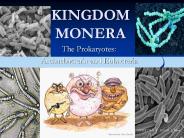Coccus PowerPoint PPT Presentations
All Time
Recommended
Bacteria The kingdom Monera Basic Shapes of Bacteria Coccus ... diplobacillus streptococcus streptobacillus staphylococcus ... presentation format: On ...
| PowerPoint PPT presentation | free to view
Microbiology. Prokaryote Architecture. Simple in shape, but genetically and biochemically advanced. General Prokaryote Shapes. Coccus round or spherical. Bacillus
| PowerPoint PPT presentation | free to download
Protist, Fungi, Bacteria and Lichens bacillus Coccus Spirillium Strepto Staphlo Bacteria s Tail (Flagella) Bacteria s Tail (Flagella) Amoeba Kingdom ...
| PowerPoint PPT presentation | free to download
4th Bertinoro Computational Biology (BCB) Meeting ' ... Strepto-coccus spp. Lacto-bacillus spp. Clostridium spp. Trp-T-boxes TRAP. Tyr-T-boxes PCE ...
| PowerPoint PPT presentation | free to download
Microbiology-Microscopy and Staining Microbiology Chapter 3, pp. 50-73. What is the smallest object ever seen? SPM of a Bacillus Bacterium SPM of Coccus Bacterium ...
| PowerPoint PPT presentation | free to view
Need organic molecules as an energy source ... Spheres: Coccus. Rods: Bacillus. Spirals: Spirilium. Classified by their arrangements ...
| PowerPoint PPT presentation | free to view
What is the smallest object ever seen? SPM of a Bacillus Bacterium. SPM of Coccus Bacterium ... Can other animals 'see' other parts of the EM spectrum? An Application ...
| PowerPoint PPT presentation | free to view
(2) the morphology of the organism is coccus, and (3) the growth of the organism is chain ... (morphology organism-2 coccus 1.0) 29. 3.2 Combining belief functions. 30 ...
| PowerPoint PPT presentation | free to download
Center for Remote Sensing and Computational Ecology ... G. breve. Tricho-desmium. Benthic Flora. Synecho- coccus. Relict. DOM. Predator. Closure ...
| PowerPoint PPT presentation | free to download
Coccus. Rods. Bacillus. Squigglies. Spirillum. Reproduce rapidly. Generation time ~20 minutes ... Ex: Penicillin, amoxicillin, tetracycline, erythromycin, etc. ...
| PowerPoint PPT presentation | free to view
Cell walls lack peptidoglycan, a carbohydrate found in the cell ... spherical (coccus or cocci) rod-like (bacillus or bacilli) helical (spirillum or spirilla) ...
| PowerPoint PPT presentation | free to view
Coccus: spherical. Spirillum: spiral. Bacterial Structure. Endospores. Thick walled structure surrounding chromosome and bit of cytoplasm ...
| PowerPoint PPT presentation | free to view
Likely organism Pneumococcus--the most common gram positive coccus found in pneumonia ... 60 y.o. female patient with Pneumonia was found to have fluid in the ...
| PowerPoint PPT presentation | free to view
May be carried in respiratory tract for long periods and ... Gram coccus. Increasingly resistant to antimicrobial agents. Commonly occurs as carrier state ...
| PowerPoint PPT presentation | free to download
Isolate organelles to study their function. isolation is accomplished by ... mesosome. 17. Prokaryotic Cell. basic cell shapes. coccus - sphere. bacillus - rod ...
| PowerPoint PPT presentation | free to view
binary fission, type of reproduction. peptidoglycan, cell wall ... coccus. bacillus. spirillum. draw the three basic shapes. 5. Bacterial Culture and Staining ...
| PowerPoint PPT presentation | free to view
Bacillus = rod-shaped. Spirillum = coiled. Coccus. Bacillus. Spirillum ... Some live in hot sulfur springs where they convert sulfur to energy ...
| PowerPoint PPT presentation | free to view
Bacteria. Chapter 5 - The Microbial World. Size of Bacteria ... Coccus. Chain = Streptoccus. Cluster = Staphylococcus. Bacillus. Chain = Streptobacillus ...
| PowerPoint PPT presentation | free to view
A population of spherical cells with a diameter of 1 ... a. bacillus. b. coccus. c. spirillum. d. filamentous. BACK TO GAME. Topic 2: Prokaryotic Cell Walls ...
| PowerPoint PPT presentation | free to view
... that inhabit extreme (very salty, hot, acidic, or low-oxygen) environments ... Staphylococcus a cluster of coccus bacteria. Escherichia coli rod-shaped bacteria ...
| PowerPoint PPT presentation | free to view
Bacillus (rod-shaped) Coccus (spherical) Diplococcus (pairs) Streptococcus (chains) ... E.g. the Dead Sea. Thermophiles (in very hot places) E.g. Hot springs ...
| PowerPoint PPT presentation | free to view
1 ds circular loop of DNA. Shapes of the Bacteria. Bacillus. Coccus. Vibrio. Spirillum. Spirochete. Pleiomorphism- Some bacterial shapes vary within a culture. ...
| PowerPoint PPT presentation | free to view
Rod-shaped. Coccus. Round-shaped. Spirillum. Spiral-shaped. Archaebacteria ... that live in Hot acid waters (like near the hot springs in Yellowstone ...
| PowerPoint PPT presentation | free to view
Microbial Cell Structure. Features common to all cell types ... Typical coccus: ~ 1 m (e.g. Staphylococcus) Typical short rod: ~ 1 x 5 m (e.g. E. coli) ...
| PowerPoint PPT presentation | free to view
Fig. 18-6 The Eukaryotic Tree of Life. Diversity of Bacterial Forms. Coccus. Bacillus. Spirillus. A Prokaryotic Cell. Fig. 20-3. Rhizopus (bread mold) life cycle ...
| PowerPoint PPT presentation | free to view
sphere (coccus, cocci) spiral (spirillum, spirilli) pleomorphic. Cell arrangement: single cell ... Meiosis two stage process reducing the chromosome number ...
| PowerPoint PPT presentation | free to view
Virus detected in 150 species of birds and mammals. ... coccus. bacillus. spirillum. p.334. Bacterial shapes. One of several ways of classifying bacteria. ...
| PowerPoint PPT presentation | free to view
Coccus: spherical. Spirillum: spiral. Bacterial Structure. Endospores ... Cocci) Gram Negative: Thinner outer layer of peptidoglycan, purple dye rinses off, pink (ex. ...
| PowerPoint PPT presentation | free to view
Wake-up Explain briefly the difference between the lytic and lysogenic cycles. List anything you can remember about prokaryotic cells (Bacteria).
| PowerPoint PPT presentation | free to view
MCB 2010L Organism Classification Domain Archaea Includes the extremophile bacteria Not looking at examples in lab Domain Bacteria Subkingdom Cyanobacteria blue ...
| PowerPoint PPT presentation | free to download
Se describe la forma en cómo era percibida por parte de la comunidad científica del siglo XVIII a la grena cochinilla.
| PowerPoint PPT presentation | free to download
1. Transformasi masuknya DNA telanjangkedalamselbakterisehinggaterjadiperubahanmaterigenetikselbakteri. Contoh: Streptococcus . pneumoniae, Neisseria
| PowerPoint PPT presentation | free to view
Rhizoid Colony Formation Bacillus subtilis. These gram positive, sporeforming rods produce colonies which are dry, flat, and irregular, with lobate margins.
| PowerPoint PPT presentation | free to view
... are Unicellular May not always appear as single cells able to communicate with one another through a process called quorum sensing.
| PowerPoint PPT presentation | free to download
Pemanfaatan Energi Biomassa sebagai Biofuel : Konsep Sinergi dengan Ketahanan Pangan di Universitas Muhammadiyah Yogyakarta Nike Triwahyuningsih, Rahmat Adiprasetya
| PowerPoint PPT presentation | free to download
Mutualists (bacteria and host both benefit) Unicellular, colonial, filamentous ... phototaxis: movement toward light. chemotaxis: movement to chemicals ...
| PowerPoint PPT presentation | free to download
Staph lives on our skin. And sometimes it gets in. Making ... Staphylococcus aureus. Opportunistic pathogen: makes toxins. Skin abscesses. Food poisoning ...
| PowerPoint PPT presentation | free to view
Identifying and Classifying Bacteria What is a prokaryote? Cells that lack a true nucleus. Cells that lack membrane-bound organelles. Most surrounded by a cell wall.
| PowerPoint PPT presentation | free to download
Board Review Paul O Keefe April 16, 2003 Skin/Soft Tissue Infections Impetigo Cellulitis Fasciitis Impetigo Group A streptococcus, Staphylococcus arueus Superficial ...
| PowerPoint PPT presentation | free to download
Culture transfer tools ... 2. Reflame the loop and cool it. ... 6. Reflame the loop and cool it. 7. Streak as at D. 8. Label the plate and incubate it inverted. ...
| PowerPoint PPT presentation | free to view
Pericarditis Causes: I. Infection: is the most important cause: Cobalt pear cardiomyopathy. Pear can. Lead to Radiation therpay . Clinical Finding Depond on the ...
| PowerPoint PPT presentation | free to download
Microbiology Laboratory Procedures Woods Lamp Testing Microsporum may fluoresce under a black light ( Woods Lamp) Approx 60% of Canis will fluoresce.
| PowerPoint PPT presentation | free to download
Divides in 20 minutes under optimal conditions. Widely used in molecular biology ... adapted strains but also, equine, swine, domestic bird (chicken) Flu strians ...
| PowerPoint PPT presentation | free to view
Board Review Paul O Keefe April 16, 2003 Skin/Soft Tissue Infections Impetigo Cellulitis Fasciitis Impetigo Group A streptococcus, Staphylococcus arueus Superficial ...
| PowerPoint PPT presentation | free to download
Bacteria Structure and Function Prokaryote & Eukaryote Evolution Cellular Evolution Current evidence indicates that eukaryotes evolved from prokaryotes between 1 and ...
| PowerPoint PPT presentation | free to download
KINGDOM MONERA The Prokaryotes: Archaebacteria and Eubacteria Methanogens These Archebacteria are anaerobes. They make methane (natural gas) as a waste product.
| PowerPoint PPT presentation | free to download
Bacteria consist of only a single cell, but don't let their small size and seeming simplicity fool you. They're an amazingly complex and fascinating group of creatures.
| PowerPoint PPT presentation | free to view
Chapter 4. Functional Anatomy of Prokaryotic and Eukaryotic Cells ... Protoplast. Gram-positive cell without cell wall. Spheroplast ...
| PowerPoint PPT presentation | free to view
Lab Practical I Kingdoms through Plantae Basic shapes (types) of bacteria Be able to find the shapes in this kind of Organism? Kingdom? Red Sox divisional win!
| PowerPoint PPT presentation | free to view
... agent for tuberculosis) easy to recognize in sputum, amidst numerous organisms. sputum sample containing. M. tuberculosis. Special Stains ...
| PowerPoint PPT presentation | free to view
Nutrient broth: liquid media (trypticase soy broth, TSB) ... Micrococcus luteus (yellow) Serratia marcescens (red) 6. Isolation Technique. Fig. 3.3 ...
| PowerPoint PPT presentation | free to view
Pathogenic bacteria worth mentioning * Enterococcus: E. faecium, E. faecalis Formerly part of Group D Strep, found in GI tract Cause of nosocomial, wound infections ...
| PowerPoint PPT presentation | free to download
Bacteria Structure and Function Prokaryote & Eukaryote Evolution Cellular Evolution Current evidence indicates that eukaryotes evolved from prokaryotes between 1 and ...
| PowerPoint PPT presentation | free to download
VIRUSES Bacteria Chapter 18 Viruses & Bacteria
| PowerPoint PPT presentation | free to download
























































